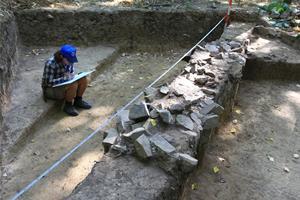Szymon Zdziebłowski / PAP - Science and Scholarship in Poland
Source - http://www.naukawpolsce.pap.pl/en/news/

Documentation of discoveries. Photo by T. Bochnak
Archaeologists from the Institute of Archaeology, University of Rzeszów together with foreign partners study vast necropolis consisting of nearly 100 mounds, erected in the 1st millennium BC in Teliţa-Celic Dere in the south-east of Romania.
The sixth season of excavation ended in early October. Luckily for archaeologists, the studied cemetery adjoins a settlement, which will allow the researchers to explore in depth the contemporary community.
"It used to be a place of great strategic and trade importance - told PAP Dr. Tomasz Bochnak from the Institute of Archaeology, University of Rzeszów. - Not far from there was a ford, which was the last passage through the lower Danube. Further to the east the delta started and crossing was no longer possible."
According to the researcher, the place had already been mentioned by the "father of history" - Herodotus, who wrote that the Persian king Darius, preparing an expedition against the Scythians in 512 BC, moved the army through the Bosphorus and to the lower Danube. Researchers believe that the trail of Darius led through the valley above which the burial ground is located.

Barrow - cenotaph explored during this season excavation. Photo made with a drone. Photo by Maria Magdalena Stefan and Dan Stefan/Digital Domain
The excavations of burial mounds show that the place had been a cultural melting pot for several centuries. Scythian and Greek influences overlapped in the region, which archaeologists see in the objects excavated from ancient tombs.
"There is no clear answer to the question of who was buried in the mounds" - said Dr. Bochnak. "The general name of the peoples who lived in the eastern and central parts of the Balkan Peninsula in the first millennium is the Thracians. These tribes had frequent contacts with the Greeks, and later the Romans" - explained the scientist.
The area where the cemetery is located, Dobrogea, was called "Little Scythia" (which indicates a significant influence of the nomadic people), and a few dozen kilometres to the southeast, on the Black Sea, Greek colonies were located.
"We believe that the settlement complex in Teliţa-Celic Dere is one of the most important sites in Dobrogea, documenting the penetration of these diverse influences. The purpose of our expedition is to determine the range of sites, inventory barrows and study those previously unexplored" - said Dr. Bochnak.
Scientists were intrigued by mound concealing two graves - burial of a young boy whose skull shows signs of trepanation. After cremation, the remains of the deceased were placed in the lateral part of the extensive mound. In the central part, the archaeologists found only unburned legs of another deceased.
"The rest of the body had been removed, but it was not a robbery, only part of a funeral ritual, as in the burial pit remained a short sword typical for the Scythians, and dozens of arrowheads. Probably soon after the funeral, the grave was opened and a large part of the body of the deceased removed" - theorised the researcher.
This year, researchers studied a mound, which turned out to be empty. It turns out that approximately 30 percent mounds of Celic Dere are cenotaphs, structures similar to graves, but devoid of human remains. Dr. Bochnak believes that they could belong to the people whose bodies could not be buried, like people who drowned or were killed in battle.
Polish team of researchers also participated in excavations within the settlement. The researchers wanted to ensure that its residents lived in the times when the necropolis was active. First results indicate a positive answer.
Head of the project, in which Polish archaeologists participate, is Prof. Valeriu Sîrbu from the Museum in Brăila. Also involved are archaeologists and geophysicists from Digital Domain SRL and Vasile Pârvan Institute of Archaeology of the Romanian Academy in Bucharest, Aristotle University of Thessaloniki and the Museum of Tulcea.